Location and Background :
West Bengal is the eastern state of mighty India. The state is bestowed with the Himalayan range in its north sharing a part of it with Nepal. Situated in the north-south mountain ridge, named as Singalila Ridge lays a mystic place popularly called as ‘SANDAKPHU’.
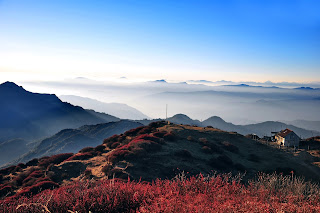 |
| sunset @sandakphu |
It is also called as Sandakpur. Located at the elevation of 3636 meters above the sea level this place is adorned with mesmerizing landscapes and enchanting environment. Having the height of 11, 292 ft. make this place the highest peak of West Bengal.
| Landscape of Sandakphu |
Let’s have a deeper insight about the background of
this place. Sandakphu or Sandakpur got
its name derived from Tibeto-Burma Lepcha language which means ‘the height of
poisonous plants’. It got its name because the Aconite plants were lavishly found
in this place, centuries ago. This is a poisonous plant that, if ingested, acts
rapidly causing vomiting, breathing and heart problems and leads to death.
There is no specific antidote of this poison. This plant also has a medicinal
value as it is used to treat certain allergies and pain in Ayurveda.
Sandakphu’s biggest claim to fame is its summit from
where the panoramic view of the mighty Kanchenjunga range quenches the thirst
of trekkers, explorers and nature lovers. We shall dive into the details with
the following trail.
Reasons to choose / Specialties:
Landscapes
Sandakphu is a hilly region acclaimed with the perfect view of the third highest peak of the world, Mount Kanchenjunga (8586 m) from its summit. The summit is popular as it provides the opportunity to glance at the four top peaks of the world.
Sunrise golden light on Mt.Everest |
The mighty Mount Everest (8848 m) is visible between Mount Lhotse (8516) and Mount Makalu (8463 m). Every turn from Maneybhanjyang has a scenic beauty that embodies the heavenly feeling as defined by the literary scholars in their compositions. The clouds seem to get perfectly aligned between the huge rocky cliffs. The milky white color of the clouds perfectly blends with the reddish brown mountain ridges as we proceed towards the apex. Green tall trees accompany the road that has been made for traveling. The steepy curvy road adds thrill to every motor rider. It is composite of pastures, valleys, rifts and many chunks of barren lands too giving the overall look of a fascinating habitation.
Climate:
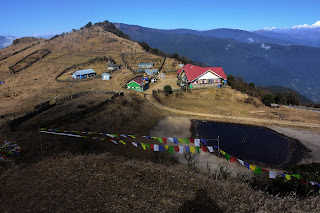 |
| landscapes on the way to Sandakphu |
Spring (March to May) brings the best version of this place with multiple bloom of various flowers. Every wild flower seems to be enchanting. Red and pink Rhododendrons with white Magnolias along with its pacifying fragrance become the main attraction for all. Whether it’s the dwellers or the tourists, everyone gets fascinated with various colours all around. The temperature during spring remains pleasant during the day with 15-20 degrees which drops during the night to lesser than 10 degrees.
| Foggy afternoon at Kalpokhari |
The temperatures during autumn remains bit cold during the day with 10-15 degrees and nights are colder than the hazy and damp day.
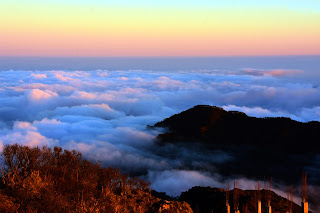 |
| sunset from sandakphu |
Autumn (September to November) make the days vibrant and sunnier. The temperature ranges between 13 to 15 degrees but tends to quickly drop down to 8 degrees to zero at night. It is an ideal time for the explorers as the mild atmospheric conditions makes it convenient for them to enjoy the warmth during the day and enjoy the chills of the night. Trekkers and photographers get the best view of sunrise and sunsets throughout this phase. The golden hours during this season embarks the magical charm of nature.
 |
| Cold days at Kalpokhari |
Winter (December-February) has its own charm with snowfall and icy-cold atmosphere. Mostly people gather for winter trek where experiencing snow is the main agenda. The temperature ranges from 6- 7 degrees during the day and up to -11 degrees at night. Misty mornings of December and twilights of January platter an array of varied landscape. February offers a fresh ambience where air feels to be refined from dust and haze. Overall, winter has a lot to offer for the adventure fanatics.
Singalila National Park
This park was declared as Wildlife Sanctuary in the year 1986 and Indian National Park in the year 1992. This region is in use as the trekker’s route from Maneybhanjyang to Sandakphu. River Ramman and River Srikhola flow through it. It’s a home to variety of wildlife.
Flora and fauna
Sandakphu is a heavenly abode for numerous high altitude plants and animals. Singalila being the National Park is a wildlife preservation centre for these precious beings. A lot of research work takes upon this region periodically.
Flora:
The entire ridge is covered with thick bamboo, enormous oak, magnolia, silver fir and dense thickets of rhododendron forests. The ridge looks spectacular during spring with bright red rhododendron flowers.
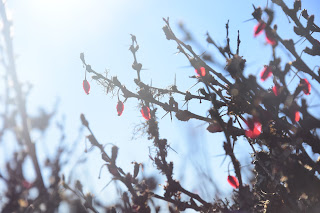 |
| Flora |
These flowers have various medicinal values too. During post monsoon season Sandakphu gets covered with the wildflowers bloom such as Primula, Geranium, Saxifraga, Bistort, Senecio, Cotoneaster and abundant orchids. Not to forget that this place is also a home for many poisonous plants like Aconite and Himalayan Cobra Lilies (Arisaema).
Fauna:
Birds – The place is a hub of Himalayan birds
accommodating over 120 species like White Crapped redstart, Grey-Sided Bush
Warbler, Spotted Nutcracker, Rock Pigeon, Large Hawk-Cuckoo, Himalayan Griffon,
Darjeeling Woodpecker, Yellow-Billed Magpie, Eurasian Nutcracker, Large Bulled
Crow, Green-Backed Tit, Whistler’s Warbler, Red Necked Phalarope, Whiskered
Yuhina, Stripe-Throated Yuhina, Rufous-Vented Yuhina, Chestnut-Crowned Laughing
Thrush, Hoary-Throated Barwing, Spotted Laughing Thrush, White-Collared Blackbird,
Verditer Flycatcher, Rufous-Gorgeted Flycatcher, Pied Bushcat, Gray Bushcat,
Gray Wagtail, Olive Black Pipit, Kalej
Pheasants, Olive Backed Pipit, Golden Bush Robin, Fire-Tailed Sunbirds, Scarlet
Minivet, Blood Pheasant, Satyr Tragopan, Brown And Fulvous Parrotbills,
Fire-Tailed Myzorins , The Gold Breasted Fulvetta etc. The migratory birds are
always a charisma of this ridge.
 |
| Red Panda |
Animals – Red Panda one of the endangered species, yellow throated marten, orange billed squirrel, leopard cat, barking deer, wild boar, pangolin, barking deer and the pika. There are larger mammals such as Himalayan Black Bear, Leopard, Clouded Leopard, Serow and the Takin. Tigers are often found wandering but the availability of their chose prey making this place a rare base for their residence.
Indo-Nepal borders view
Sandakphu is a shared ridge between India and Nepal. Hence, it is very interesting to see many areas whose left wing belongs to Nepal and the right belongs to India and vice versa. From Lamaydhura one side belongs to Nepal and other to India. Meghma is another small village that is located in the Indo-Nepal border. Tumling is a small hamlet that belongs to Nepal with maximum residents belonging to the Gurung families. Almost 15 kms away lays Kalapokhri that is another meeting point of Indo-Nepal. There are few check posts of Nepal in these boundaries.
Population
Being on the Himalayan altitudes and close to Nepal maximum dwellers of Sandakphu belong to Sherpa and Gurung families. However, the settlement of other Nepali families has grown to a certain extent with the advent of commercialization.
Religion
The primary religion followed here is Buddhism. Chitre and Meghma are famous for tis monasteries. It is a prayer place for the Buddhists. The bright colorful prayer flags, called as, Loongdaar increases the beauty of this place
Types of Houses
Plenty of cottages and huts with small rooms are to be found in this place. The traditional design of typical hill cottages is interesting to explore with the entire classic kitchen where earthen oven, locally called as Chula is still in use.
Sunrise at Sandakphu
sunrise at sandakphu
This is the main reason that pulls visitors to this
place and where many dreams come true.The blue hour beholds the most
captivating moment of sunrise. Amidst the Himalaya the entire horizon seems to
become mystical for a while. The gradient of colors from blue to orange
illuminates the soft and cool light all around. The white clouds gradually
float on the peaks of the green and rocky valley that creates a spellbinding
scenario.
The first ray of sunshine falls on the Himalayas – the Everest, the Kanchenjunga and the entire range of Sleeping Buddha. The new day begins with the message that every morning is a blessing for us so we should feel ourselves privileged to welcome new day along with its challenges.
Sunsets at Sandakphu has its own magic. The blazing sun with its fiery gleam leaves the horizon filled with compelling upshot. The rays of sun come in an angle diffusing the bright daylight and fill theatmosphere with blended hues of calm and serenity.
The layers of clouds move in proper sync followed by the pink and purple sky. The sky seems to be preparing itself to welcome the moon with all its kind gestures
The famous Land Rovers of Sandakphu:
It was during the British era when the Land Rovers
were used by the tea estate owners for convenient traveling in the bumpy road
of multi-terrain hills. The British left but these vehicles remained. Sandakphu
is probably the only place in Darjeeling where Land Rovers exist till now and
it is still being in use for the local transportation. It is true that only the
seasoned drivers are capable enough to drive on the treacherous curves of this
hill. The love and respect for this
vehicle makes it a heritage at present.
Though other vehicles have been built efficient
enough to ply still visitors prefer to have a ride of Land Rovers for a
lifetime experience.However, the Government of India has constructed new
road covering halting points from Maneybhanjyang to Gairibas making it bit easy
for the trekkers and travelers on vehicles. Gravel and stone bedded road begins
from Gairiba
Trek :
Trekking is one of the popular methods of exploring Sandakphu. The trek route passes through the Singalila National Park. It begins from Maneybhanjyang (7,054 ft.) which is the gateway. It can be easily reached from NJP via direct taxi. One night stay here and the next day with all the necessary passes the trek begins.
 |
| Trekkers Going towards Sandakphu |
The next halt is Chitre (8,340 ft.) after 3 kms (1.5 hours). Further, is a small hamlet named Lamaydhura (8,792 ft.) after 1.5 hours trek. The trail heads towards Meghma (9,514 ft.) for 1.5 hours. The next halt would be Tonglu (10,130 ft.) after a steep climb for 1 hour. The trek descends on the next day towards Tumling (9,600 ft.) for an hour. After an hour of trek the entry point of Singalila National Park arrives. Now, the trek descends towards Gairibas (8,600 ft.). It is the best place to stay overnight due to the grasslands surrounded by bamboo thickets and pine trees. Next day begins with a steep climb for about 2 kms reaching Kaiyakatta.
 |
| Map For Trekkers |
The trek continues for 3 long hours till Kalapokhri (10,400 ft.). The black pond gives its name due to the existence of black water. The black colour is due to the mud and water here never freezes. It is considered to be sacred. After the overnight stay in Kalapokhri the trek ascends for 40 mins towards Bikhey Bhanjyang. Finally after a good long walk of 2.5 hours the summit of Sandakphu (11,929 ft.) arrives.
The onward route is optional either via Gurdum as shown in the fig above or by ascending the same trail as it went.
Motor Vehicle
The Land Rover travel begins from Maneybhanjyang early morning.
 |
| Landrovers at Sandakphu |
Passing through the concrete road of Chitre, Meghma, Tumling and gravel road from Gairibas to Sandakphu the travelers can enjoy the varied landscapes. It takes around 3-3.5 hours to reach Sandakphu.
When to visit
8 months excluding May to August is the best time to
visit Sandakphu. The Singalila Park remains closed during monsoon due to heavy
downpour. Every season has its magnificent curtain of wonders for the visitor.
Details are provided in the ‘Climate’ section of this page.
How many days enough
A leisure visit of 4-5 days is enough to explore and enjoy the place if the visitors are planning to hire vehicle. A detailed trek ranges from 5-6 days to 8-9 days
Cost and Packages
Customized packages can be made by contacting the tour
operators. Local hotels and homestays provide budget friendly stays. A group
trek package depends upon the organizers.
Hence, Sandakphu welcomes each
soul who is seeking to find the inner calm by being really close to the nature
for inspiration. It is a dream pinnacle for the adventure lovers as the trek is
apt for the beginners with minimum preparation.
From the environmentalists to the researchers, laymen to the experts,
photographers to the filmmakers, everyone takes back an enormous
chronicles of a lifetime experience.



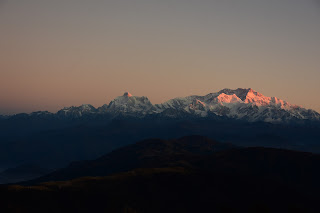

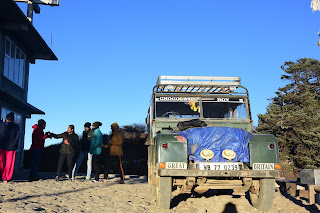











0 Comments